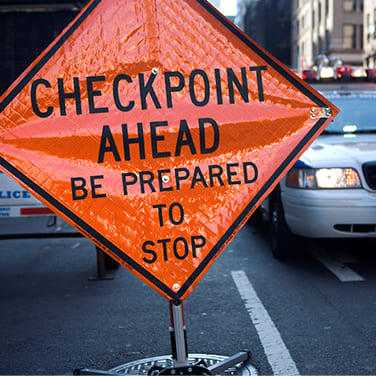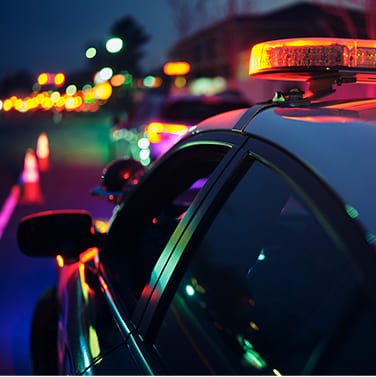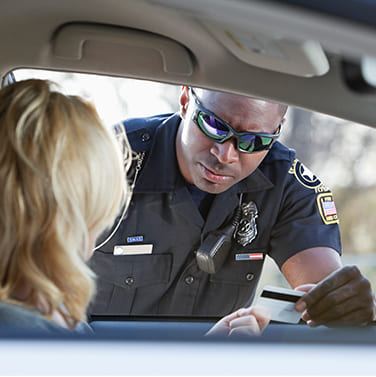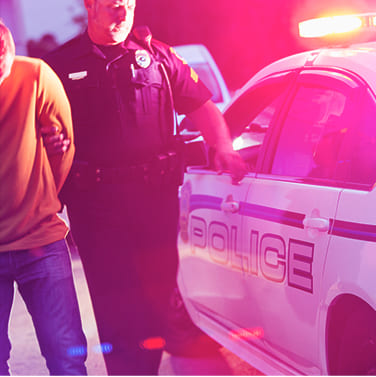High Visibility Law Enforcement
Since its creation in 1980, MADD has worked side-by-side with law enforcement, launching the Campaign to Eliminate Drunk Driving in response to more than 13,000 people who were being killed each year.
These brave men and women put their lives at risk every day and are often themselves victims of impaired drivers.
MADD supports law enforcement heroes who keep our roads safe and we applaud their efforts to help us end drunk and drugged driving.

Sobriety checkpoints with high-visibility traffic safety enforcement are a key element of MADD’s Campaign to Eliminate Drunk Driving.
The primary purpose of these high-visibility efforts is to catch drunk drivers, communicate to potential offenders that there is no tolerance for impaired driving, and to help end drunk and drugged driving once and for all.
By supporting high-visibility traffic safety enforcement, we’re also saving lives as sobriety checkpoints have proven to reduce drunk driving fatalities by 20 percent.

What is a checkpoint?
Impaired driving checkpoints are a highly organized and coordinated screening of drivers as they pass through an area where traffic is diverted by law enforcement. The intention is to briefly engage randomly selected motorists in a conversation on the side of the road while officers closely examine the driver’s behavior, language and movements. Officers look for signs of impairment that indicate the driver’s inability to safely travel on the road, presenting a danger to themselves, their passengers and other motorists. Checkpoints are a critical component of high-visibility traffic safety enforcement, and the publicity surrounding them helps serve as a deterrent to drunk and drugged driving.
How are checkpoints conducted?
Officers conducting checkpoints will:
- Engage drivers in a systematic pre-determined sequence. For example, selecting every vehicle, every third vehicle, or every fifth vehicle and so on, depending on expected traffic load at the designated time and location.
- Speak with drivers. If officers develop any reasonable suspicion that a motorist is exhibiting impairment, they will request the driver exit the roadway to an area where other officers will engage the motorist and make a more detailed assessment of the driver’s condition.
- If the motorist is asked to exit the roadway, the officer will attempt to confirm a reasonable suspicion of impairment.
- The motorist will be asked to exit the vehicle and perform standardized field sobriety tests to determine the degree of impairment.
- If, in the opinion of the assessment officers, the motorist is too impaired to safely operate a motor vehicle, the motorist is arrested and further evidentiary tests are conducted to determine the substance(s) and the degree of impairment.
- If no impairment is present, those drivers will be allowed to proceed.
All officers assigned to the checkpoint are required to wear a highly visibly reflective traffic safety vest. Each MADD staff member and volunteer assisting with the checkpoint should also be so dressed and follow associated protocols for their personal safety.
Why do checkpoints?
- The primary goal of a sobriety checkpoint is not to arrest people, but rather to deter people from committing DUI.
- Sobriety checkpoints help stop drunk drivers who would likely remain under the radar.
- The publicity from checkpoints reminds people who drink that drinking and driving don’t mix.
- Research shows that for every dollar invested in checkpoints, communities save between $6 and $23 in costs from alcohol-related crashes.
- The annual cost of alcohol-related crashes to society is over $100 billion.
- Research shows that checkpoints, if done correctly, can be effective with as few as three to five officers.

One of the cornerstones of MADD’s Campaign to Eliminate Drunk Driving® is high-visibility traffic safety enforcement to both catch drunk drivers and — equally important — to deter others by sending a strong message that if you drive impaired, you will get caught. MADD has designated the Saturday before Labor Day weekend as Saturation Saturday, a day to team up with law enforcement departments nationwide to amplify the message that if you choose to drive impaired, you will get caught. MADD volunteers and staff coordinate with their local departments to host media events, roll call briefings and sobriety checkpoints to show support for officers conducting high-visibility enforcement. The campaign is aimed at lowering drunk driving crashes and fatalities during one of the busiest travel weeks of the year.

MADD also supports the National Highway Traffic Safety Administration and law enforcement in their impaired driving crackdowns. After all, to deter potential drunk drivers, they have to know enforcement is out there. The crackdowns do just that – let people know that law enforcement is keeping a special eye out for drunk drivers during dangerous parts of the year.
What can you do to help? You can be the eyes and ears to help prevent drunk driving by learning the signs of a drunk driver and what to do when you see one here.

